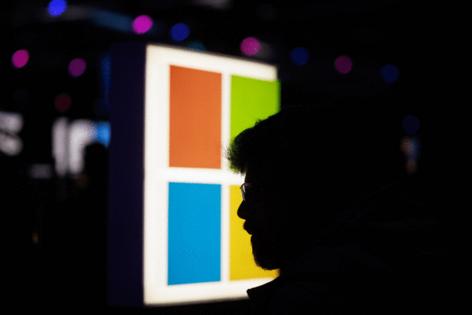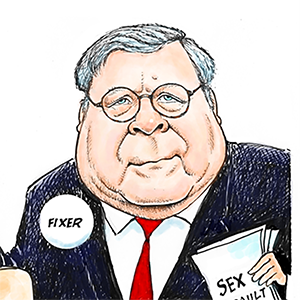Behind Microsoft's layoffs: A new attitude shaped by AI
Published in Business News
Microsoft's layoff waves — the latest arrived Wednesday — are leading some employees to ask themselves two questions: Am I next? Will there be another job out there for me?
The Redmond-based tech giant laid off more than 6,000 employees in May, followed up by an additional 305 in early June. The company kicked off its fiscal year in early July by eliminating 9,000 more workers.
Explanations as to why the world's most valuable company is shedding workers at a pace rarely seen in its history have been vague and, for the employees who might be next, unpersuasive. The company says it wants to flatten management layers and trim redundant roles. But employees are seeing those around them plucked away without much explanation.
Like other companies during the pandemic, Microsoft swelled. The company's head count reached a record 228,000 people worldwide in 2024, a year after sweeping layoffs across the industry. Tech experts and analysts say it may be prudent to take the company at its word, that the sheer size of the workforce isn't as necessary as it was a few years ago. Before AI, some of Microsoft's biggest investments were in payroll. But now it needs to build data centers and buy expensive hardware from companies like Nvidia.
What we have seen in the past 15 years is the supersizing of the tech sector, and certain companies like Microsoft have been at the forefront," said Margaret O'Mara, a historian at the University of Washington who writes about tech. "Everything got bigger and faster because there was so much money being made. That money can now be deployed differently. The bottom line is, how many people do these companies really need?"
For company veterans recently cut loose, Microsoft's apparent return to a culture of looming layoffs and poor communication has stopped what they saw as a positive evolution.
"I'm a Microsoft advocate, but it's really hard and sad to see Microsoft turn its back on what was a kinder and nicer work environment," said Kelly Bowen-McCombs, a 25-year Microsoft veteran who was laid off in 2024.
Microsoft didn't tie the layoffs to performance issues or target specific sorts of roles. The company said it needs nimble, agile teams to run the artificial intelligence race and is cutting costs to invest billions in AI.
Microsoft is tossing those thousands of employees, 3,120 in Washington so far this year, into a crowded, decidedly chilly labor pool. For the first time in decades, it's not a given that an employer will chase an unemployed tech worker for a job.
Tech's labor market has been tight before. In late 2022 through the first half of 2023, Microsoft, Amazon, Google and Meta laid off tens of thousands as a counterbalance to pandemic overhiring.
But hiring picked back up quickly and tech's job growth stayed relatively flat with a few spikes. Paul Turek, an economist for the Washington state Employment Security Department, said that might not be the case this year.
"It's pretty tough to find another tech company that will hire you at this point in time," Turek said. Tech sector hiring, he continued, could tip into the negative by winter.
Bold new AI frontier
As former Microsoft employees searching for work feel the squeeze, some who survived the layoffs feel a shift in the company's culture in the wake of the launch of ChatGPT, an AI-powered chatbot from Microsoft-backed OpenAI, in late 2022.
Microsoft pushed all of its chips into the technology. The company soon incorporated its AI assistant Copilot into the suite of Office products and offered AI tools for employees.
Microsoft sees AI as a technology that brings as fundamental a shift to society as electricity. The company also forecasts a change within, as AI skills become as valuable as coding skills were a decade ago.
The era of Microsoft as the gentle tech giant may be ending as well.
Once known as the bully in the room, Microsoft under CEO Satya Nadella fostered a reputation of an innovative but compassionate tech company. Microsoft avoided much of the scrutiny companies like Meta and Amazon face for their cultures.
The AI race raises the stakes for Microsoft. The company met the cloud computing revolution unprepared and has no desire to be caught flat-footed again. So far this year, the company has pumped $80 billion into AI infrastructure investments. That's enough to cover the city of Seattle's budget over the past 13 years.
With money flowing out and a fuzzy timetable for return on investment, Microsoft is cutting costs. And the employees who joined Microsoft for the culture may be at risk.
Job searching
A data scientist who's been working for Microsoft for several years said she turned down a competing offer worth twice her current compensation to work for Microsoft, in part to avoid the other company's intense culture. She asked not to be named to protect her job.
"I decided to work here, and I really like my job," she said. "The problems are challenging but interesting."
At Microsoft, she said, there's been a balance between innovation and speed. Deadlines were assigned that fit the work required.
But in the past year or so, she's noticed a shift. Teams in her division were working backward from a deadline. Demands for speed intensified.
She also noticed a more watchful eye from higher-ups, with more metrics put on her team than before. She said there's pressure to use AI tools, and that the company measures the use of Copilot in Microsoft's code repository, GitHub.
Microsoft leadership is bullish on internal AI use, with claims that as much as 30% of the company's code is written by AI tools. The developer-focused Build conference Microsoft held in May was devoted to "agentic" AI, technology that goes beyond generating content from specific prompts and instead acts on a user's behalf.
The company recently introduced an AI question to its biannual employee-sentiment survey. About a year ago Microsoft first asked employees whether they feel they're learning ways to apply AI to their work.
For one cloud organization, the score for that question was one of the lowest last year, according to memos seen by The Seattle Times. Douglas Phillips, a corporate vice president for an Azure organization, said in a December memo to employees they would "look for additional opportunities to … use AI in their work."
Like most of her colleagues, the data scientist is also being tracked on her number of days in the office.
There's no threat or implication of enforcement if in-office time or Copilot usage metrics aren't met. Coupled with the layoffs, though, the increasing surveillance can fuel fears.
If the company is collecting data, you don't want to leave anything that might raise eyebrows, she said.
"We don't know the factors for how they're getting rid of people," she said. "I'm not the only one job searching right now, but it's a very intense job market."
Structural change
The labor market as a whole is tightening, in strange ways.
While unemployment rates are relatively low and payroll growth remains steady, the economic outlook is uncertain.
Tech has been historically immune to unfriendly labor markets and economic downturns. Like health care, tech has been able to produce job growth in some of the toughest times.
But major technological advances have altered the makeup of tech workforces before. The internet's proliferation in the 1990s created a boom/bust cycle that spawned a challenging labor market, like one tech workers could face soon.
Turek, the economist with Washington state, said the internet caused structural change in the job market. People who had worked in tech since it was a fledgling industry lost their jobs, but then new ones were created to meet a new age.
"The question we have now is, what does that path look like? Are we going to see more people lose jobs than gaining jobs?" Turek said.
Microsoft emphasizes upskilling for AI. The company's push to tack Copilot onto almost every product stems from a corporate philosophy that everything be done with help from a robot.
Microsoft hasn't tied the advances of AI to job losses, though some of its tech peers have. Sales software platform Salesforce recently said that it's hired fewer engineers and customer service reps due to AI adoption. Amazon CEO Andy Jassy told employees he expects the e-commerce giant's corporate head count to fall as AI makes its way into every corner of the company.
As Microsoft pumps money and employee hours into AI development, roles and even whole teams could be cut.
For employees, that creeping feeling that they could be next is bringing a familiar sentiment from a much more competitive time in Microsoft's history.
Old Microsoft
Bowen-McCombs worked at Microsoft for just shy of 25 years. Then she talked herself out of a job, as she tells it.
She was a principal product manager for the Microsoft 365 Developer Program, a platform that allowed outside developers to build off Microsoft products. She argued for more resources for her team for about a year, but it was hard to get investment that wasn't directly connected to AI after Copilot launched in 2023.
In January 2024, the company agreed as it moved her program to India to cut costs.
"I managed to get new positions for my team," Bowen-McCombs said. "They did not find a place for me."
She was told in June 2024 she'd be let go. Less than a year later, her husband, another veteran Microsoft worker, was also among the thousands of Washington employees laid off. His login access was cut off the morning he received a termination notice.
"I am beyond disappointed in how Microsoft has been handling this," Bowen-McCombs said. "I know they're pivoting to AI, but it doesn't feel like the culture Satya had been trying to foster."
She recalled her brief time under founder Bill Gates and her years under CEO Steve Ballmer, who took over in 2000 before giving up the top job to Nadella in 2014. Microsoft was cutthroat then, she said, always wondering who you threw off the bus first.
But Nadella felt like a breath of fresh air. He celebrated diversity and inclusion and tried to foster people's careers.
In her last couple of years, she felt a shift though, a slow ratcheting back to "Old Microsoft."
"From a business perspective, I understand the need to reorient, to contract," Bowen-McCombs said. "I just don't think they're being very honest about it. I don't know what the right way to get laid off is, but I'm appalled that people were laid off by conference calls or notified by losing access. It's just so impersonal."
After the layoffs in May, some employees said they had been blindsided. Rumors swirled in the days leading up to it, and managers had few answers themselves. Some showed up to work and soon received an invitation to a meeting where they were terminated along with dozens of others in their division, on anonymous conference calls.
A product designer, who's been with Microsoft for almost 13 years, echoed Bowen-McCombs' sentiments. She said she remembers a pre-Nadella era. The paranoia, fear and backstabbing from fellow team members.
"It's not a pleasant place to be right now; everyone's sharpening their knives," said the designer, who asked not to be named to protect her job. "I can't lose my job right now, especially not in this job market."
She also felt a tonal switch happen right after the May wave of layoffs.
A week after Microsoft cut more than 6,000 people, it held its massive Build conference in Seattle. Nadella aired a recorded video conversation between himself and Tesla CEO Elon Musk to discuss the latter's AI models being developed on Microsoft's platforms.
"A week after these layoffs, Satya chooses to have Elon Musk, the man who orchestrated the mass layoffs in the federal government, onstage," the product designer said. "What message are we supposed to take from that?
©2025 The Seattle Times. Visit seattletimes.com. Distributed by Tribune Content Agency, LLC.

















Comments